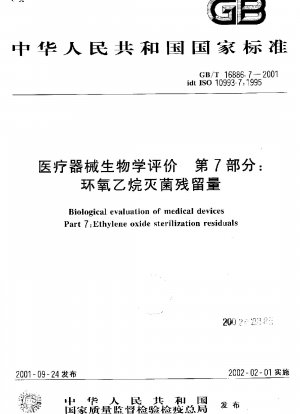GB/T 16886.7-2001
Biological evaluation of medical devices--Part 7:Ethylene oxide sterilization residuals (English Version)
- Standard No.
- GB/T 16886.7-2001
- Language
- Chinese, Available in English version
- Release Date
- 2001
- Published By
- General Administration of Quality Supervision, Inspection and Quarantine of the People‘s Republic of China
- Status
- 2017-01
- Replace By
- GB/T 16886.7-2015
- Latest
- GB/T 16886.7-2015
- Scope
- This standard specifies the allowable limits of ethylene oxide (EO) and 2-chloroethanol (ECH) residues on medical devices sterilized by ethylene oxide, and the measurement methods for ethylene oxide and 2-chloroethanol and methods for determining whether a device can be released. Additional background information and guidance are given in the appendices to this standard prompt. This standard does not cover those ethylene oxide sterilized devices that do not come into contact with patients (eg, in vitro diagnostic devices).
GB/T 16886.7-2001 history
- 2015 GB/T 16886.7-2015 Biological evaluation of medical devices—Part 7: Ethylene oxide sterilization residuals
- 2001 GB/T 16886.7-2001 Biological evaluation of medical devices--Part 7:Ethylene oxide sterilization residuals

GB/T 16886.7-2001 -All Parts
GB/T 16886.1-2022 Biological evaluation of medical devices—Part 1: Evaluation and testing within a risk management process
GB/T 16886.10-2017 Biological evaluation of medical devices—Part 10: Tests for irritation and skin sensitization
GB/T 16886.11-2021 Biological evaluation of medical devices—Part 11: Tests for systemic toxicity
GB/T 16886.12-2023 Biological Evaluation of Medical Devices Part 12: Sample Preparation and Reference Materials
GB/T 16886.13-2017 Biological evaluation of medical devices—Part 13: Identification and quantification of degradation products from polymeric medical devices
GB/T 16886.14-2003 Biological evaluation of medical devices--Part 14: Identification and quantification of degradation products from ceramics
GB/T 16886.15-2022 Biological evaluation of medical devices—Part 15: Identification and quantification of degradation products from metals and alloys
GB/T 16886.16-2021 Biological evaluation of medical devices—Part 16: Toxicokinetic study design for degradation products and leachables
GB/T 16886.17-2005 Biological evaluation of medical devices.Part 17:Establishment of allowable limits for leachable substances
GB/T 16886.18-2022 Biological evaluation of medical devices—Part 18: Chemical characterization of medical device materials within a risk management process
GB/T 16886.19-2022 Biological evaluation of medical devices—Part 19: Physico-chemical, morphological and topographical characterization of materials
GB/T 16886.2-2011 Biological evaluation of medical devices.Part 2: Animal welfare requirements
GB/T 16886.20-2015 Biological evaluation of medical devices.Part 20:Principles and methods for immunotoxicology testing of medical devices
GB/T 16886.23-2023 Biological Evaluation of Medical Devices Part 23: Stimulation Test
GB/T 16886.3-2019 Biological evaluation of medical devices—Part 3: Tests for genotoxicity, carcinogenicity and reproductive toxicity
GB/T 16886.4-2022 Biological evaluation of medical devices—Part 4: Selection of tests for interactions with blood
GB/T 16886.5-2017 Biological Evaluation of Medical Devices Part 5: In Vitro Cytotoxicity Tests
GB/T 16886.6-2022 Biological evaluation of medical devices—Part 6:Tests for local effects after implantation
GB/T 16886.7-2015 Biological evaluation of medical devices—Part 7: Ethylene oxide sterilization residuals
GB/T 16886.9-2022 Biological Evaluation of Medical Devices Part 9: Qualitative and Quantitative Framework for Potential Degradation Products